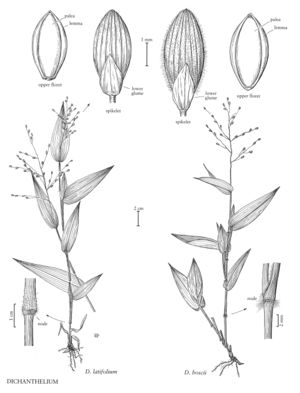Dichanthelium boscii
Plants forming small clumps, with knotty rhizomes less than 2 mm thick. Basal rosettes well-differentiated; sheaths pubescent; blades ovate to lanceolate, dark green. Culms 25-75 cm, initially erect, often sprawling in the fall, nodes densely retrorsely bearded; internodes glabrous, or pilose with papillose-based hairs; fall phase branching from the midculm nodes, branches nearly erect, sparsely rebranching, blades and secondary panicles only slightly reduced. Cauline leaves 4-6, often with a transitional leaf above the basal rosette; sheaths not overlapping, bases puberulent to retrorsely pilose, margins ciliate, collars pubescent; ligules 0.4-0.9 mm, membranous, ciliate, cilia longer than the membranous portion; blades 3-6 times longer than wide, 15-40 mm wide, ovate-lanceolate, glabrous, puberulent, or pilose, with 11-15 major veins and 40-120 minor veins, bases cordate, margins with papillose-based cilia. Panicles 4-12 cm long, 4-12 cm wide, about as long as wide when fully expanded, partially included to tardily exserted, with 16-60 spikelets. Spikelets 3.8-5.2 mm long, 1.7-2.2 mm wide, narrowly ellipsoid, pubescent or puberulent. Lower glumes 1/3 – 1/2 as long as the spikelets, narrowly triangular; upper glumes shorter than the spikelets; lower florets usually staminate; upper florets pointed, with a minute tuft of hairs. 2n = 18,36.
Distribution
Conn., N.J., N.Y., Del., W.Va., Fla., Tex., La., Tenn., N.C., S.C., Pa., Va., D.C, Ala., Ark., Ill., Ga., Ind., Md., Kans., Okla., Ohio, Mo., Miss., Ky., Mass., R.I.
Discussion
Dichanthelium boscii usually grows in semi-open areas in dry oak-hickory woods of the eastern United States. The primary panicles are open-pollinated and are produced from late April through June (and some¬times again in the fall); the secondary panicles are partly open-pollinated, and are produced from July through September.
Selected References
None.
